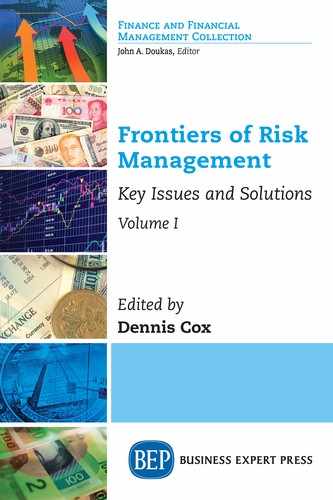“A Consistent, Global Approach to Risk” (Ferguson), 187–189
Against the Gods (Bernstein), 3
ALM. See Asset liability management
Alternative investments, 109
Assessment, 123–125
Asset liability management (ALM)
case study, 60–64
case study solutions, 65–67
dynamics, 56–57
implementation issues, 67–70
implementing robust framework, 57–59
policy objectives, 56–57
Asset pricing, 44–45
The A Team (TV show), 127
Balance sheet model assumptions
core deposit behavior, 96
new business assumptions, 94–95
prepayment assumptions, 96–97
rate scenarios and driver rates, 94
repricing attributes, 95
run-off schedules, 95–96
starting, 93–94
Balance sheet, nature of, 73–74
Bank regulation
complexity of requirements, 170–172
current state of, 167–168
high-level principles, 179–183
pushing towards precipice, 172–176
reasons, 165–167
volume of, 168–170
Basel Capital Accord, 190–191
Basel I, 170
Basel II, 9–10, 178–179
Basel III, 9–10, 183–184
Basis risk, 78, 121–122
Bernstein, Peter, 3
Binomial pricing, 133–137
Canfield Solitaire, 128–129
Capital adequacy, 57
Capital risk, 81
CEBS. See Committee of European Banking Supervisors
Chandler, Raymond, 127
Citigroup, 187–189
Committee of European Banking Supervisors (CEBS), 183
Committee of Sponsoring Organizations (COSOs), 81
Competitive threat, 23–24
Complete markets, 136
Convexity risk, 120
Core deposit behavior, 96
Corporate finance, 36–37
Correlation risk, 121–122
COSOs. See Committee of Sponsoring Organizations
Cost-per-transaction variance, 142–143
Counterparty credit risk, 79
Credit derivatives market
automated access, 216–217
bird’s-eye view of, 207–208
complex datasets, 217
convergence of equity, 222–224
credit trading desk challenges, 212–214
cross-asset infrastructure, 222
current challenges, 210–212, 224–225
effortless extension and customization, 221–222
growth, 208–210
position keeping, 221
pricing framework, 218–221
spread curve engine, 217–218
streamlined trade processing, 216
trade capture, 214–216
Credit risk, 7, 32, 46–47
Credit risk model (CRM) framework
data cleaning, 193–194
data warehousing, 199–200
history at Citigroup, 191–192
model structure, 194–195
performance/validation, 195–198
reference dataset for modeling, 192–193
software solution, 198–199
Credit trading desk challenges, 212–214
Cultural challenges, 14–15
Culture change, 142
DAPR. See Dynamic anomaly and pattern response
Delta, 120
Derivatives
classification of, 115–119
pricing, 132–133
risks associated with, 119–122
role of, 114–115
Discount rate risk, 122
DMADV, 158
DMAIC, 158
Dominance of earnings, 82
Due diligence, 100–102
Duration of equity, 90
Dynamic anomaly and pattern response (DAPR), 157, 158
Dynamic models, 91–92
EAR. See Earnings at risk
Earnings at risk (EAR), 82–86
ECC. See Environmental consistency confidence
Economic value added (EVA) approach, 8
Economic value of equity (EVE), 88–91
Elasticity of options, 121
Enterprise risk management (ERM), 5–6, 81
Environmental consistency confidence (ECC)
definition of, 139
using support vector machines, 151–153
in wholesale financial institutions, 156
ERM. See Enterprise risk management
ETD. See Exchange-traded derivatives
European Central Bank, 104
European investment bank, 160
EVE. See Economic value of equity
Exchange-traded derivatives (ETD), 115–116
Fee income and service charge, 56
Ferguson, Bryce, 188
Financial risk, 32
Financial Services Authority (FSA), 103–104
Forward-based derivatives, 117
Forward contract, 117
FSA. See Financial Services Authority
Funding liquidity risk, 79
Futures contract, 117–118
General risk areas, 31–33
Global commodities firm, 160–161
Growth fund, 44
Hammersley, D.C., 128
Handscomb, J.M., 128
Hedge fund managers
due diligence, 100–102
failure of, 104–106
ongoing risk management, 106–111
overview of, 99–100
regulation, 102–106
Historical volatility, 121
ICAAP. See Internal capital adequacy assessment process
Internal capital adequacy assessment process (ICAAP), 12, 13
Investment Advisors Act, 103
Investment and derivatives portfolio risks, 79
Investment risk, 113
Investment styles, 43–44
Investor relations, 11–12
Key performance indicators (KPSs), 149
Key risk indicators (KRIs)
appropriate selection, 36–37
characteristics of, 148
definition of, 143–144
importance of, 144–148
setting and interpreting, 38
template, 149
KPSs. See Key performance indicators
KRIs. See Key risk indicators
Leverage effect, 120
Liquidity risk, 49–50
Litigation risk, 32
Loan quality, 56
Market risk, 7, 32, 42–43, 113
Market risk management, 122–123
Market value of equity (MVE), 56
Minimum compliance, 4
Model risk, 45–46
Monte Carlo Methods (Hammersley and Handscomb), 128
MVE. See Market value of equity
Net interest income (NII), 56
NII. See Net interest income
Ongoing risk management, 106–111
Operational risk, 33, 47–48, 107, 109
Operational value-at-risk, 141
Option-based derivatives, 119
Option contract, 118–119
Option grantor, 119
Option risk, 78
Organizational readiness, 24
Over-the-counter (OTC) derivatives, 116–119
Performance attribution, 45
Pi, 128–129
PKRI⇔LI approach, 149–151, 156
Proactive portfolio management, 8–9
Process modeling, 141
RAROC. See Risk-adjusted return on capital
Reduction of variance, 117
Reference dataset, 202–205
Regulatory relations, 12
Regulatory risk, 32
Repricing attributes, 95
Repricing mismatch risk, 77
Reputational risk, 32, 48–49
Risk-adjusted return on capital (RAROC), 8
Risk areas
general, 31–33
specific, 33–36
Risk communication, 4–5
Risk dashboards, 142
Risk Disclosures of Banks and Financial Firms, 10
Risk disclosure standards, 10–11
Risk environment, 30–31
Risk information systems, 6
Risk management
classification of derivatives, 115–119
future of, 50–51
market, 122–123
ongoing, 106–111
role of derivatives, 114–115
Risk Management Association (RMA), 6
Risk-neutral probability, 133
Risk regulation, 181–183
Risk silos, 6–7
RMA. See Risk Management Association
Run-off schedules, 95–96
Sarbanes-Oxley Act, 4
Self-deception, 38
Silo-based approach, 6
The Simple Art of Murder (Chandler), 127
Simulation and Monte Carlo, 130–132
6S, 157
Specific risk areas, 33–36
Spread management, 56
Staff development, 7–8
Standardization of futures contracts, 117–118
Static models, 91–92
Strategic opportunity risk, 22–28
Strategic risk, 48
as boardroom responsibility, 18–19
developing world and, 21–22
four-step plan, 19–21
overview of, 17–18
potential consumer, 22
types of opportunity, 22–28
Stress testing, 109
Supervisory outsourcing, 13
Support vector machines (SVMs), 151–153
Swap agreement, 118
Team recruitment trap, 25
Time decay, 121
Treasury
direct responsibilities, 75
indirect responsibilities, 75
risk management, 76–81
US Securities and Exchange Commission (SEC), 103
Value-at-risk (VaR) approach, 6
Variance, 117
Volatility risk, 121
Wall Street community, 104
Wholesale financial institutions, 139–140
Yield curve risk, 77–78
